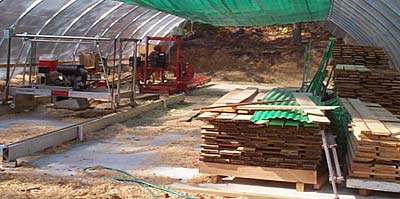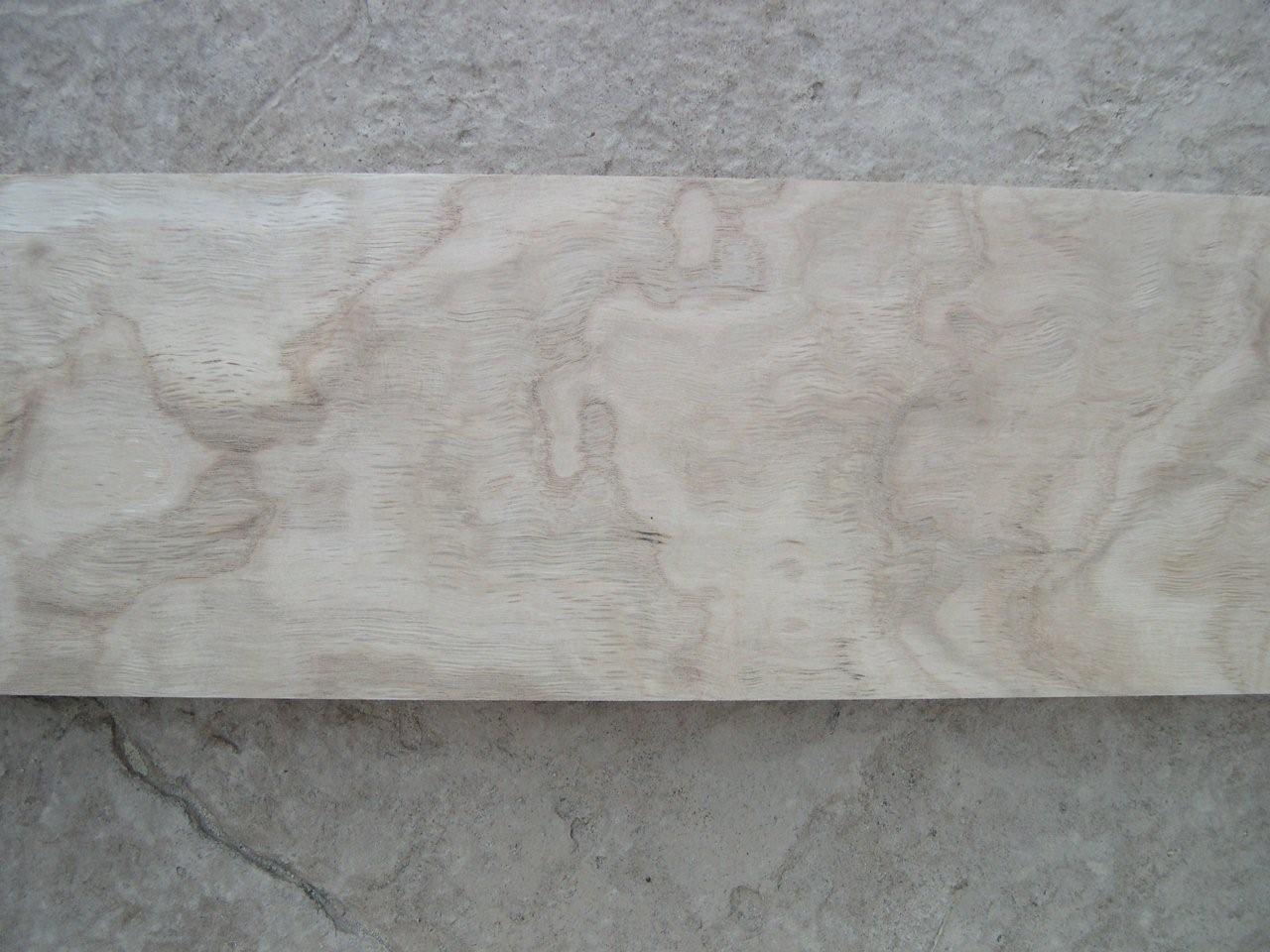Swing blade vs band mill
Is one better suited to cutting large cants? August 13, 2002
Question
Isn't it a lot easier to cut large cants with a band mill instead of swing blade because of having to double cut? I've heard a lot about Wood-Mizer cutting 1" red oak, which is the toughest test of all. And I've heard you have to double cut with a Peterson mill. I'm going to buy a mill soon and don't know which would be best all around.
Forum Responses
Swing blade doublecutting is as easy as it gets on the Peterson. It'd probably take you a matter of seconds to cut a 10x20" board. It's getting it off the log that is the mission. 1" boards are not a problem!
Remember, the wider the board on a band, the more chance the band will either ride up or down.
With the swing mill you handle stuff once - this includes the log - maintenance is low and double cutting on the Peterson is so easy. They were doing some 16" cuts at Springfield and they looked great. The WM is still a great machine. They all have good and not-so-good points.
From contributor P:
I got the 8 inch Peterson and the LT 15 plus a Nyle kiln. I don't go portable, although I could with the Peterson. I work alone and saw mostly high-grade hardwood logs, the bigger the better. I kiln dry them and sell to furniture makers/woodworkers. As the business grows, I hope to also get a molder/planer, maybe the Logosol.
A swingblade and a band mill are very different tools. Using the Peterson, I can take a 4 foot diameter log and break it down into a bunch of 8 inch square cants, move them over to the WM and make boards. An 8 1/4 cant off the Peterson will give me 7 4/4 boards with very little waste. No kerf loss from the Peterson, plus I can rotate the cant on the WM to high grade or, with oak and figured hard wood, I can get a lot more quarter sawn boards than with just a bandsaw. Also, my bandsaw blades stay sharp twice as long, the Peterson does all the bark and that blade is a cinch to sharpen or retip. Both mills together were under $14k.
Double cutting with the Peterson is easy, but I seldom do it, as with hardwood, heading to the kiln with 6 and 8 inch boards works best for me. I work by myself and would not be able to turn the big hardwood logs on the bandsaw unless I had hydraulics, which would mean a $30k+ machine that still would not be as flexible as having two different types of mills.
They are very different tools and I would not be without either one of them. There are a number of good band mills out there, but there is only one swing blade worth getting.

From contributor A:
If price is the determining factor, you will do better with a swinger than a band mill. If you wish to turn out large timbers, it is better if you can "box the heart" and a hydraulic band mill is the way to go. A 4x12x30' timber can not be picked up by hand, anyway. I can handle the log with the tractor and mill without breaking a sweat. I can pick the timber up with the toe rollers and pluck it off with the tractor without any problems.
Red oak is not hard to saw and my WM eats it like butter. Hickory or elm would separate the mills from the toys. (I eat them also but chew slowly.) I can saw out a 6x28x12' walnut bar top or 1/2x4x8' cedar closet lining. As for the trimming issue, you can push the flitches over on the forks and then dump them back on the deck and saw them to the size you want. If you saw out a 4x10 and decide that you need something else smaller, you can clamp it back on and re-saw it into 2x4's if you wish.
Each has its place and use. I have a 16 lb sledge and a 16 oz trim hammer - both will drive 6d nails.
I think you'll be very happy with a swing mill. It will do what you seem to want easily, and at a great price. Once you use one a while you'll realize how versatile they are. Double cutting is easy, and very accurate. Peterson is my choice - they are an impressive machine!
If you are a swing, you better have big logs (over 24"). You will recv more quatersawn boards with a swing. Bandsaw boxing the heart is easy. Also, you can stress saw with a bandsaw. I have found that taking out such a large piece of wood using a swing arm saw makes you run a clean up before taking an expensive timber.
From contributor P:
Contributor A, I have moved those large timbers with ease. There is a well-designed tool that moves large timbers if you have a smooth, hard surface (either packed dirt or a cement pad). It is my favorite tool, called the Jr. arch.
I also have a log arch and a capstan winch. I don't have any fork lift/tractor to move logs. I am not a production business, but with these simple tools, I can handle cants and oak logs 30 inches in diameter, 12 feet.
With my capstan winch, I have 150 feet of rope. It does a good job for me and will pull some pretty big stuff down a slope, but of course does have its limits. I like that when it reaches the limit, the engine just stalls instead of things breaking. Having a pulley really helps to lift the log a little and pull in the best direction.
From contributor A:
Those tools sound neat. But I live in the Ozarks. There is no flat ground and my sawmill sits on top of a ridge and if a log on wheels got away, it would go to the bottom of the holler and they would both stay there. Every once in a while I drop a log and it rolls down to the tree line. I am getting a good berm line now.
Contributor P, love your enclosure. What is it? Are the ends open? Are exhaust and dust a problem? I'm in the middle of building a roof for my mill/edger, but it's pretty crude compared to your setup. Did it cost much?
From contributor P:
It is a greenhouse, 27' by 52', and it cost about $2500. The plastic should last at least 5 years and only cost $150 and a day to replace. I have used duct tape in a few places to patch where a board poked through, but no real problem. The expensive part was the cement pad, but was worth it. Since the picture, I framed in the ends with 6 foot doors and moved the Wood-Mizer up across from the swinger. I now use the end half as a showroom, selling the finished kiln dry stuff. Works slick. I also have stickered three kiln loads of hardwood air drying (abt 6000 bf), plus I can continue to air dry in the winter. I open doors in winter when running. No exhaust problem in summer - I just open up the ends and roll up the sides for venting, plus old tarps for shade. The greenhouse is the New England model by Griffin.
Contributor P, you might want to get a second enclosure for your dry wood. It would be a shame for all that sterile lumber to get infested with critters from your mill waste.
From contributor P:
I have moved both mills up to the front and keep the waste away from the sterile kiln dried stuff. Your point is a very good one - it is really important to keep the end product in good shape or you have wasted a lot of effort to get it to that point if it degrades. I also use the greenhouse effect to keep the average moisture content down in the show room area.
I own two Mobile Dimension Sawmills. I would never part with them other than to get a third. I have found, for cutting dimensional lumber by myself and for production reasons, it is the best on the market. I operate strictly by myself and with these units I am self-sufficient. I have even devised a method to attach a slabber unit from Lucas that can cut a 6o" slab up to 8" thick and 18' long. I am also capable of sawing logs up to 41/2' in diameter and 24' long as well as timber to 8" x 12" without rolling the log and 24' long.
The comments below were added after this Forum discussion was archived as a Knowledge Base article (add your comment).
Comment from contributor H:
With my Lucas 27 mill, I recently sawed 6 beams 8"x12"x22 ft from Doug fir logs 22" in diameter. I sawed them all by myself in two hours, including unloading the mill from my pickup, sawing and reloading the mill. Also got a lot of nice 2"x6" and some 1" stock in the process. The guy that is using a swing saw to saw cants and then using the bandsaw to resaw the cants is wasting a lot of time, material and quality. The swingsaw will give you higher yield with quarter saw, flat saw or any combination in between as you progress into the log.

